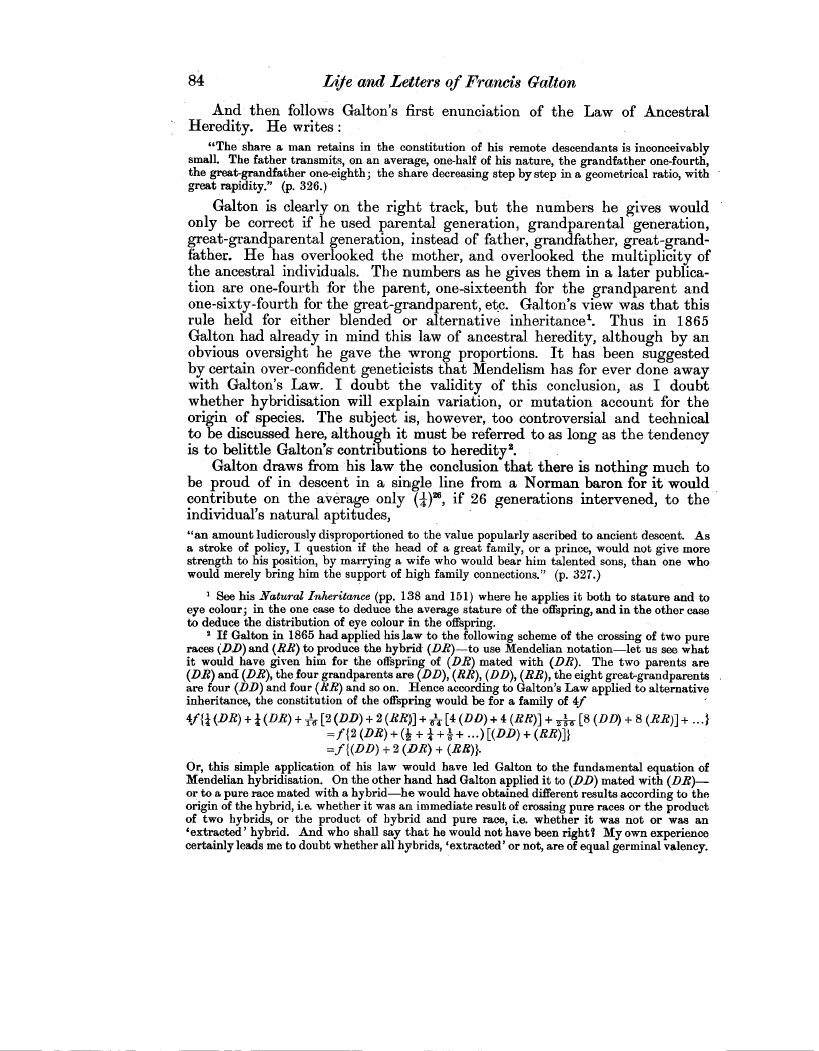84 Life and Letters of Francis Galton
And then follows Galton's first enunciation of the Law of Ancestral Heredity. He writes
"The share a man retains in the constitution of his remote descendants is inconceivably small. The father transmits, on an average, one-half of his nature, the grandfather one-fourth, the great-grandfather one-eighth; the share decreasing step by step in a geometrical ratio, with great rapidity." (p. 326.)
Galton is clearly on the right track, but the numbers he gives would only be correct if he used parental generation, grandparental generation, great-grandparental generation, instead of father, grandfather, great-grandfather. He has overlooked the mother, and overlooked the multiplicity of the ancestral individuals. The numbers as he gives them in a later publication are one-fourth for the parent, one-sixteenth for the grandparent and one-sixty-fourth for the great-grandparent, etc. Galton's view was that this rule held for either blended or alternative inheritance'. Thus in 1865 Galton had already in mind this law of ancestral heredity, although by an obvious oversight he gave the wrong proportions. It has been suggested by certain over-confident geneticists that Mendelism has for ever done away with Galton's Law. I doubt the validity of this conclusion, as I doubt whether hybridisation will explain variation, or mutation account for the origin of species. The subject is, however, too controversial and technical to be discussed here, although it must be referred to as long as the tendency is to belittle Galton's- contributions to heredity'.
Galton draws from his law the conclusion that there is nothing much to be proud of in descent in a single line from a Norman baron for it would
contribute on the average only (q'-,)'s, if 26 generations intervened, to the
individual's natural aptitudes,
`°an amount ludicrously disproportioned to the value popularly ascribed to ancient descent. As a stroke of policy, I question if the head of a great family, or a prince, would not give more strength to his position, by marrying a wife who would bear him talented sons, than one who would merely bring him the support of high family connections." (p. 327.)
' See his Natural Inheritance (pp. 138 and 151) where he applies it both to stature and to eye colour; in the one case to deduce the average stature of the offspring, and in the other case to deduce the distribution of eye colour in the offspring.
2 If Galton in 1865 had applied his law to the following scheme of the crossing of two pure races (DD) and (RR) to produce the hybrid (DR)-to use Mendelian notation-let us see what it would have given him for the offspring of (DR) mated with (DR). The two parents are (DR) and (DR), the four grandparents are (DD), (RR), (DD), (RR), the eight great-grandparents are four (DD) and four (RR) and so on. Hence according to Galton's Law applied to alternative inheritance, the constitution of the offspring would be for a family of 4f
4f {} (DR) + I (DR) + 1 [2 (DD) + 2 (RR)] + ~~ [4 (DD) + 4 (RR)] + s a [8 (DD) + 8 (RR)] + ... } = f {2 (DR) + (J + a +. + ...) [(DD) + (RR)]} =f {(DD) + 2 (DR) + (RR)}.
Or, this simple application of his law would have led Galton to the fundamental equation of Mendelian hybridisation. On the other hand had Galton applied it to (DD) mated with (DR)or to a pure race mated with a hybrid-he would have obtained different results according to the origin of the hybrid, i.e. whether it was an immediate result of crossing pure races or the product of two hybrids, or the product of hybrid and pure race, i.e. whether it was not or was an
extracted' hybrid. And who shall say that he would not have been right I My own experience certainly leads me to doubt whether all hybrids, 'extracted' or not, are of equal germinal valency.

